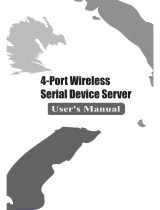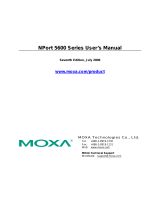
Table of Contents
1. About This Manual ................................................................................................................................ 6
2. Getting Started ..................................................................................................................................... 7
Installing Your NPort Device Server .......................................................................................................... 7
Wiring Requirements ...................................................................................................................... 7
Connecting the Power ..................................................................................................................... 8
Grounding the NPort Device Server .................................................................................................. 8
Connecting to the Network .............................................................................................................. 9
Connecting to a Serial Device .......................................................................................................... 9
LED Indicators ............................................................................................................................... 9
Beeper Definition ......................................................................................................................... 11
RS-485 Port’s Adjustable Pull High/Low Resistor ............................................................................... 11
Windows Utility for the NPort ................................................................................................................ 11
Configuration by Web Console ............................................................................................................... 12
Opening Your Browser .................................................................................................................. 12
Quick Setup (excluding the NPort 5100, 5200, and IA5000 Series) ..................................................... 15
Export/Import (Excluding the NPort 5100, 5200, and IA5000 Series ................................................... 17
Basic Settings .............................................................................................................................. 19
Network Settings .......................................................................................................................... 22
Serial Settings ............................................................................................................................. 28
Operating Settings ....................................................................................................................... 31
Accessible IP Settings ................................................................................................................... 33
Firmware Upgrading Compatibility Check ................................................................................................ 34
Account Management ........................................................................................................................... 35
Notification Message ..................................................................................................................... 35
User Account ............................................................................................................................... 36
Password and Login Policy ............................................................................................................. 37
Auto Warning Settings .................................................................................................................. 38
Monitor ....................................................................................................................................... 43
System Log Settings ............................................................................................................................ 45
Change Password ......................................................................................................................... 46
Load Factory Default ..................................................................................................................... 47
Configuration by Telnet Console ............................................................................................................ 47
Configuration by Serial Console ............................................................................................................. 51
Serial Console (19200, n, 8, 1) ...................................................................................................... 51
Testing Your NPort ............................................................................................................................... 53
3. Cybersecurity Considerations ............................................................................................................. 54
Updating Firmware .............................................................................................................................. 54
Turn Off Unused Service and Ports ......................................................................................................... 54
Turn Off Moxa Service After Installation .......................................................................................... 54
Turn On Services That Are Necessary ............................................................................................. 54
Limited IP Access ................................................................................................................................. 55
Account and Password .......................................................................................................................... 55
System Log ......................................................................................................................................... 55
Testing the Security Environment .......................................................................................................... 55
4. Choosing the Proper Operation Mode ................................................................................................. 57
Overview ............................................................................................................................................ 57
Real COM Mode ................................................................................................................................... 57
RFC2217 Mode .................................................................................................................................... 58
TCP Server Mode ................................................................................................................................. 58
TCP Client Mode .................................................................................................................................. 59
UDP Mode ........................................................................................................................................... 59
Pair Connection Mode ........................................................................................................................... 59
Ethernet Modem Mode .......................................................................................................................... 59
Reverse Telnet Mode ............................................................................................................................ 60
PPP Mode ............................................................................................................................................ 60
Disabled Mode ..................................................................................................................................... 60
5. Advanced Operation Mode Settings .................................................................................................... 61
Overview ............................................................................................................................................ 61




























